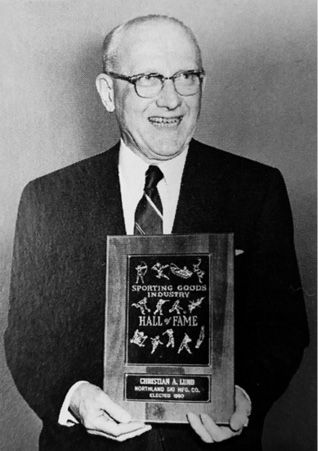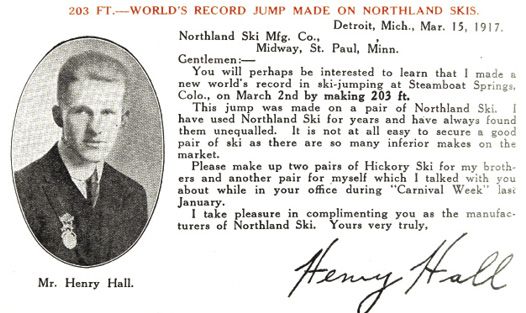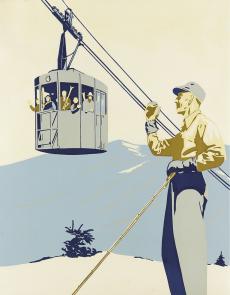SKIING HISTORY
Editor Seth Masia
Managing Editor Greg Ditrinco
Consulting Editor Cindy Hirschfeld
Art Director Edna Baker
Editorial Board
Seth Masia, Chairman
John Allen, Andy Bigford, John Caldwell, Jeremy Davis, Kirby Gilbert, Paul Hooge, Jeff Leich, Ron LeMaster, Bob Soden, Ingrid Wicken
Founding Editors
Morten Lund, Glenn Parkinson
To preserve skiing history and to increase awareness of the sport’s heritage
ISHA Founder
Mason Beekley, 1927–2001
ISHA Board of Directors
Rick Moulton, Chairman
Seth Masia, President
Wini Jones, Vice President
Jeff Blumenfeld, Vice President
John McMurtry, Vice President
Bob Soden (Canada), Treasurer
Einar Sunde, Secretary
Richard Allen, Skip Beitzel, Michael Calderone, Dick Cutler, Ken Hugessen (Canada), David Ingemie, Joe Jay Jalbert, Henri Rivers, Charles Sanders, Christof Thöny (Austria), Ivan Wagner (Switzerland)
Presidential Circle
Christin Cooper, Billy Kidd, Jean-Claude Killy, Bode Miller, Doug Pfeiffer, Penny Pitou, Nancy Greene Raine
Executive Director
Janet White
janet@skiinghistory.org
Membership Services
Laurie Glover
(802) 375-1105
laurie@skiinghistory.org
Corporate Sponsorships
Peter Kirkpatrick
(541) 944-3095
peterk10950@gmail.com
Bimonthly journal and official publication of the International Skiing History Association (ISHA)
Partners: U.S. Ski and Snowboard Hall of Fame | Canadian Ski Museum and Hall of Fame
Alf Engen Ski Museum | North American Snowsports Journalists Association | Swiss Academic Ski Club
Skiing History (USPS No. 16-201, ISSN: 23293659) is published bimonthly by the International Skiing History Association, P.O. Box 1064, Manchester Center, VT 05255.
Periodicals postage paid at Manchester Center, VT and at additional mailing offices. Postmaster: Send address changes to ISHA, P.O. Box 1064, Manchester Center, VT 05255
ISHA is a 501(c)(3) public charity. EIN: 06-1347398
Written permission from the editor is required to reproduce, in any manner, the contents of Skiing History, either in full or in part.
Northland Skis: Fire and Feud in St. Paul
How Christian Lund mopped up rivals while making the world’s best-known hickory skis.
Illustration above: Henry Hall (1893-1986), of Ishpeming, Michigan, was just one of many professional ski jumpers who swore by Northland’s hickory skis. After his 1917 world record, he served in World War I, and returned to reclaim the record in 1921, jumping 229.5 feet at Revelstoke, British Columbia.
America’s ski-making industry, as a mass-production enterprise, began along the banks of the upper Mississippi River in Minnesota. Fueled by a ready market of Norwegian immigrants and the availability of high-quality timber, men like jumping champions Mikkel and Torjus Hemmestveit set up workshops to hand-carve dozens, perhaps hundreds, of skis each year. It was Martin Strand, a civil engineer born in Rendalen, Norway, who in 1896 began mass-producing skis using power equipment, in St. Paul. But the signal success was the Northland Ski Manufacturing Co., which grew to be the largest ski-maker in the world, while producing what many considered the best hickory skis available (at least until Thor Groswold began making skis in Denver in 1934).

the U.S. Sporting Goods Industry Hall
of Fame. Courtesy Greg Fangel.
Northland’s history has for decades been shrouded in a fog of self-promotion by Christian A. Lund, who claimed, inaccurately, to have founded the firm in 1911. That was the story he pitched in the pages of his catalogs and advertising. By midcentury, the brand held iconic status, and fans had no reason to doubt the “official” origin story. The truth was more complex.
A one-page sketch of C.A. Lund’s life in the Northland 50th-anniversary catalog, published in 1961, summarized the company’s version. Titled “The Northland Story,” it includes the citation accompanying Lund’s induction into the Hall of Fame of the National Sporting Goods Association, which reads, in part:
“After coming to the United States (1901), [Lund] founded the Northland Ski Mfg. Co in 1911. The fifty years since have been spent in the development of skiing and ice hockey in this country. . . . His introduction of plastic ski bottoms, metal edged skis, perfected techniques of hickory laminations and other innovations, boosted his company to its present eminence as the world’s largest ski manufacturer... he created a new important segment of the sporting goods industry.”
But a search of archived materials in Minneapolis and St. Paul has changed the accepted narrative of the history of Lund and his ski companies. The real story is full of intrigue, betrayal and four-alarm fires. Northland, in fact, grew out of previous enterprises dating back to Strand’s first workshop in 1896.
For context, understand that between 1840 and 1910, about 250,000 Norwegians and 180,000 Swedes landed in the Minneapolis–St. Paul area. According to Gunnar Thorvaldsen of the Arctic University of Norway, one out of every nine Norwegians left Norway and one out of every 12 Swedes left Sweden during that period. The immigrants lost no time in setting up their own winter sport clubs. The St. Paul Winter Carnival, launched in 1886, was a Scandinavian winter celebration modeled after the Montreal Winter Carnival. The one-week event ended up lasting four and was a showcase for all winter activities, including tobogganing, horse racing on ice, sleigh rides, skating, curling, and, of course, snowshoeing and skiing.

factory in New Richmond, Wisconsin,
claimed to be the largest ski-maker in
the world. Courtesy Greg Fangel.
This was the spirit of the place when Martin Strand arrived in 1888, at age 25. He enrolled in the University of Minnesota and worked as a surveyor, then as a civil engineer in Superior, Minnesota. When Fridtjof Nansen’s book On Skis Across Greenland was published in 1890, Norwegian nationalism soared and skiing became an expression of Norwegian pride everywhere, especially for young men like Strand.
In 1892, Strand traveled home for a short visit and may have investigated how Norwegian skis were made. The Panic of 1893 in the U.S. brought economic collapse and a multi-year depression. For Strand, work dried up in Superior, and he returned to Minneapolis to work as a draftsman. He experimented with making skis in his basement, bending the ski tips over a steaming teapot. By 1896 he was selling skis but kept his day job as a draftsman, then later as a civil engineer again.
In 1899, city records list Strand as a ski manufacturer on Cedar Avenue in Minneapolis, but he needed another source of income and sold insurance for New York Life. There he met another salesman, a Wisconsin Swede named Frederick J. Youngquist. In 1905 they set up shop as Strand & Youngquist Manufacturing Co. As their foreman, they hired a young expert carpenter, Ole Sigurd Ellevold, who arrived in Minneapolis in 1901, to supervise manufacture of skis, oars, toboggans and baseball bats.
Little is known regarding the contractual relationship between Strand and Youngquist, but in 1907, Strand was out and Youngquist reorganized the company as the National Boat Oar Manufacturing Company.
Strand bounced back and by 1909 was again listed as a ski and oar manufacturer doing business at 2427 University Avenue, near the campus of the University of Minnesota. Strand was determined not to fail in the ski business. He did well enough to recruit Ellevold as a foreman. Then, on May 29, 1910, a fire consumed the entire plant, including his manufacturing machinery.
Any shop making wooden skis was a fire hazard. The building was full of sawdust, paint and varnish, and lumber and finished skis. Strand and Ellevold rebuilt two miles away, only to lose that building in a second fire. Three decades later, in the July 21, 1940, edition, the New Richmond News (Wisconsin) told Strand’s story:
“Two fires six months apart almost crushed him. Both times his stock was completely destroyed and the machines were ruined. The foreman of his shop [Ellevold] gave him another headache [as Strand explains]. “He knew the second fire almost broke me and he knew it automatically cancelled my lease on the building. I did not know that, but he did and he bid up on the lease so I was forced out.”

early 1930's. Courtesy Greg Fangel.
Strand, who never gave up, traveled 25 miles to New Richmond, Wisconsin, where the Chamber of Commerce desperately wanted new manufacturing businesses. They offered Strand an unbeatable deal, building him a “fireproof” masonry building. In less than a year (in 1911) Strand was back in business making skis and toboggans. He made inexpensive skis of white pine and jumping skis of hickory. Some years later he would claim to be the largest ski manufacturer in the world.
Ellevold rebuilt the Hampden Avenue factory in 1911, and in 1912 adopted a new company name: The Northland Ski Manufacturing Company, Ole S. Ellevold, President. The first two catalogues featured the young Crown Prince of Norway on the covers.
From across the street, at the Gold Coin Stock Food and Chemical Works, Christian A. Lund watched the new enterprise open with more than passing interest. Lund had arrived in Minneapolis in 1903 and by 1910 was a manager at Gold Coin.
Northland Ski Company had been established with stock values of $50,000 and a maximum liability on debt of $20,000. In 1913, Lund purchased some Northland stock. Two years later, he incorporated the C.A. Lund Company as a shell but continued selling wood finishes for Gold Coin. As a stockholder in Northland, he advised Ellevold on business matters and probably sold him wood preservatives and varnishes.

remain relevant as Northland grew.
A block or so down the street from the Northland plant, another Norwegian, Hans Gregg, manufactured wooden farm implements and skis under the Park label. By 1919, Gregg was making high-quality skis for the Dartmouth Cooperative Society in Hanover, New Hampshire. Lund may also have been selling varnishes to Gregg. It was obvious to Lund that the ski business was thriving. He continued investing in Northland stock.
By 1916 Lund owned enough Northland stock to control the company. He resigned from Gold Coin in 1918 and activated his C.A. Lund Company for the sale, and possibly manufacture, of wood preservatives. Ellevold, then 36 years old, left the business and moved to North Dakota, where he took up farming.
Lund grew the Northland brand of skis, bindings and related products, selling to high-end sporting goods and department stores. In 1927 he opened a factory in Hastings, Minnesota, to manufacture Lund-branded skis, snowshoes and toboggans as a cheaper line for hardware and general-merchandise stores.
Aside from aggressive marketing, Northland owed its success to hickory—the hardest wood available for skis (and for ax handles, wheel spokes and the like). Prohibitively expensive for European factories, hickory was a reasonable purchase in Minnesota. Northland bought boatloads, shipped from Louisiana sawmills as planks ready to be carved into skis. Northland’s hickory skis became the first choice of ski jumpers and, after 1930, for Alpine downhillers—at least until challenged, beginning in 1932, by the Groswold Ski Company in Denver.

1927, and burned down in 1945.
Then on June 4, 1937, the Woodware Worker’s Union Local 2048 filed suit against Lund, DBA the C.A. Lund Company and Northland. The suit alleged that C.A. Lund et al. had engaged in unfair labor practices, in violation of the National Labor Relations Act at both plants—six charges in all. The trial examiner and the National Labor Relations Board ruled against Lund on all charges. He was ordered to correct violations and make restitution. The incident didn’t turn Lund into a model employer afterward. The union took him back to court in 1939, and again the court ruled against Lund et al.
Meanwhile, in a bid to penetrate the New England market, Lund opened a plant in Laconia, New Hampshire. It was promoted in the New York Times as “the largest ski factory in the world.” Lund’s son, Carl, managed the plant. Lund also hired Walter F. Tubbs to manage the Northland snowshoe line.
In 1945, the Hastings plant burned to the ground, and Lund relocated to the suburb of North St. Paul.

ize on Hannes Schneider's arrival
in New Hampshire.
In an era when most ski factories served local markets, the C.A. Lund Company, marketing nationally, produced more skis than any other enterprise in the world. Less aggressive companies couldn’t compete. Martin Strand filed for bankruptcy in 1945 and died two years later. On December 3, 1953, Lund’s old St. Paul plant, the one founded by Strand and rebuilt by Ellevold, burned. Lund strolled a couple of blocks down the road and purchased the Gregg factory, then on the verge of bankruptcy. Within a couple of weeks, Northland skis were shipping from the old Gregg plant.
To be fair, we don’t know if Lund plotted to drive Ole Ellevold out of his own business, or if Lund simply bought him out when Ellevold wanted a farm. We don’t know if Youngquist pushed Strand out of their partnership, or if they parted on friendly terms. Strand did confirm that Ellevold forced him out after the 1910 fires. It is interesting that Lund, with all of his success behind him in 1961, felt the need to exaggerate his own considerable accomplishments at the expense of others.
When Lund died in 1965, the wooden ski was fast going the way of the wooden ship, washed out in an unstoppable tide of change. At the close of that year, his sons, Carl and Ambrose, sensibly sold the Northland Ski Company to Larson Industries, makers of fiberglass boats. In 1968 Larson hired Stein Eriksen to promote a line of glass skis, but it was too late. The last Northlands shipped in 1970. 
Greg Fangel is the proprietor of woodenskis.com in Tofte, Minnesota. Paul Hooge and his wife run the Hooge Haus, a bed-and-breakfast with a ski museum in Crested Butte, Colorado.

Table of Contents

Corporate Sponsors
ISHA deeply appreciates your generous support!
WORLD CHAMPIONSHIP ($3,000 AND UP)
Gorsuch
Polartec
Sport Obermeyer
Warren and Laurie Miller
CHAMPIONSHIP ($2,000)
Fairbank Group: Bromley, Cranmore, Jiminy Peak
Hickory & Tweed Ski Shop
Rossignol
Snowsports Merchandising Corp.
WORLD CUP ($1,000)
Aspen Skiing Company
Berkshire East Mountain Resort/Catamount Mountain Resort
Bogner
Boyne Resorts
Dale of Norway
Darn Tough Vermont
Dynastar | Lange | Look
Gordini USA Inc. | Kombi LTD
HEAD Wintersports
Intuition Sports, Inc.
Mammoth Mountain
Marker-Volkl USA
National Ski Areas Association
Outdoor Retailer
Ski Area Management
Ski Country Sports
Sports Specialists, Ltd.
Sun Valley Resort
Vintage Ski World
World Cup Supply
GOLD ($700)
Larson's Ski & Sport
Race Place | BEAST Tuning Tools
The Ski Company (Rochester, NY)
Thule
SILVER ($500)
Alta Ski Area
Boden Architecture PLLC
Dalbello Sports
Deer Valley
Ecosign Mountain Resort Planners
Fera International
Holiday Valley
Hotronic USA, Inc. | Wintersteiger
MasterFit Enterprises
McWhorter Driscoll, LLC
Metropolitan New York Ski Council
Mt. Bachelor
New Jersey Ski & Snowboard Council
Russell Mace Vacation Homes
Schoeller Textile USA
Scott Sports
Seirus Innovations
SeniorsSkiing.com
Ski Utah
Steamboat Ski & Resort Corporation
Sundance Mountain Resort
Swiss Academic Ski Club
Tecnica Group USA
Timberline
Trapp Family Lodge
Western Winter Sports Reps Association
World Pro Ski Tour
Yellowstone Club


